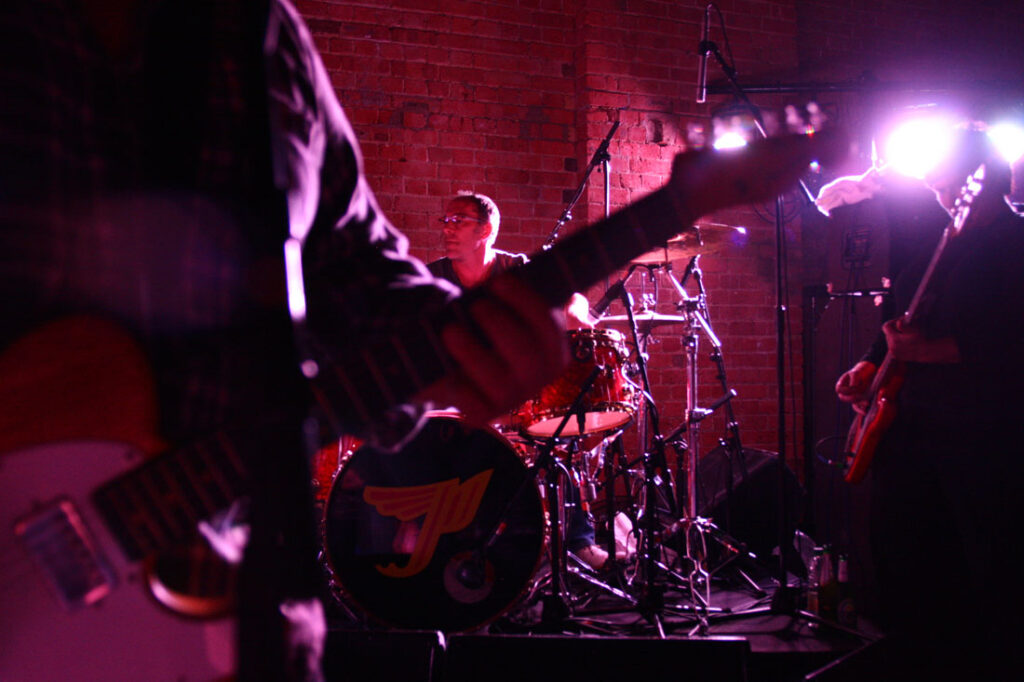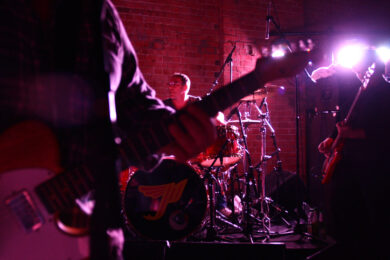Right from the start the Pixies had a torrid torrent of sound that would make your teeth rattle in your skull.
When they first washed up on these shores in 1987, touring with 4AD’s other Bostonian indie/art/punk sensations Throwing Muses, they were still pretty much an unknown quantity despite three tracks on a Sounds EP and a Melody Maker front cover. Their otherness was an assault on all fronts. In the disparate and slightly wretched music scene of the mid-80s, even the way they looked was alien to most. The Pixies played to an uneasy amalgamation of goths, punks, long-hairs, psychobillies, straight-edgers etc, which only went to highlight how utterly normal they looked. Their casual dress only helped to make them sound twice as odd; an obvious inversion of the way things are now. As much as The Quietus is a keen fan of pop and rock’s dressing-up box/escapist sensibilities, for once the visceral impact of their music was enhanced by the fact that they didn’t look like The Birthday Party or Bauhaus.
The dynamics of their sound was based around their love of high contrast, the famed Loud Quiet Loud blueprint that would go on to influence Nirvana et al. Frank Black’s masculine and devilish yowl contrasted with Kim Deal’s feminine and angelic sigh. These contrasts were often, on closer inspection, two sides of the same coin (the quietness used to amp up the creeping intensity, the noise to break the dams) or a means to subtly reverse the casual perception (Black’s jet engine roar was often used to cover a timid sensitivity and Deal’s croon often implied a sinister, dark-hearted intent).
And when the noise came it was overwhelming.
The threat of imminent virtuosity hung over Joey Santiago at all times but never quite revealed itself. Instead his guitar was made to plead, wheedle, scream and hector like the unwilling guest of a serial killer trapped down a well. Kim Deal always made like she was about to snap the neck off her bass with the bludgeoning strength of her attack. Black gave voice to a choir of disparate characters like a randomly retuning long wave radio: amorous Mexican drunkards, hectoring televangelists, roaring biblical seers, pot-crazed teens, spurned lovers. . . . Only David Lovering’s powerhouse backbeat anchored the foot of the tornado to the ground.
So perhaps it was not surprising that, first time out, the last thing that was ever mentioned about the Pixies was their lyrics. But they fitted perfectly into the band’s aesthetic, being a mix of classical allusion and gutter talk; high and low art; an amalgam of pop and literary references. They found a concrete beauty in the unmentionable and the depraved, profundity in the mundane.
Some 22 years after they first came here they’re playing in Britain again, in an art gallery. The space in Shoreditch, London Underground, is like a room turned inside out. In the rain outside the walls are covered in crappy graffiti and stencil art yet inside the brick is red and uninterrupted. The event is to launch Minotaur, a monstrous box set of pretty much everything the four-piece have ever done with demonic bells and luxurious art whistles added, inside a box that a smaller than normal fan of the band could be buried in. (Watch The Quietus for an interview with its designer Vaughan Oliver and more details on the ultra-fetishizable collector’s item next week.)
To the shock of wide-eyed punters, the band themselves wander round the venue asking for requests, and then when they have enough they take to the stage.
They may be playing to a similar sized crowd to when they first came over two decades ago but the big difference, I guess, is that these stories of biblical rape, Dadaist art, ecological disaster, mental illness and interplanetary travel have become well-loved, singalong anthems in the meantime. Their lyrics come to the fore in this gig, no longer obscured by noise, unfamiliarity and the shock of the new.
Their themes were a perversion of, or a skewed take on, the basic human needs for sex, shelter, food, warmth and intoxication. Frank Black once said that the popular perception of him as a David Lynch freak was pretty much true but that he had cooled toward the director as he’d gotten weirder and weirder and his once complex and non-judgmental attitude toward human sexuality had solidified into something that looked depressingly close to misogyny. This was reflected in the lyrics to songs such as ‘Bone Machine’ which had little to do with the vapid sexism of hair metal and the coy sexlessness of indie sucking its thumb under the twin monoliths of political correctness and AIDS panic. Sexual paranoia wrestling with dimly remembered sexual abuse was not what we were used to getting from Guns N’Roses or The Wedding Present: “I was talking to preachy-preach about kissy-kiss / He bought me a soda / He bought me a soda / He bought me a soda and he tried to molest me in the parking lot.” Again, these lines, delivered in a sing song childlike voice are the things that chill you to the marrow long after the noise has subsided.
There was even a massive gulf between the Pixies and their closest peers. From nihilistic child molestation narrative ‘Jordan, Minnesota’ by Big Black to the sneering ‘Trouser Minnow’ by Rapeman, it seemed like Steve Albini was interested in nothing but transgression for transgression’s sake. Scabrous lyrics to match his scabrous and metallic clangor. Elsewhere the Butthole Surfers were keen on putting the idiot into idiot savant, cleansing their third eyes and letting the whole acid crazed mess pour out. The content of ’22 Going On 23′, with mooing cows, sickening guitar work, Gibby Haynes thundering “Rape . . . desire” as the tape of a woman phoning into to a radio talk show to discuss being sexually assaulted, plays over the top, was enough to test the patience of even the most liberal of listeners. (Though it must be said, it still stands as one of their best tracks.) But these songs were like the vicious nihilism of Twin Peaks: Fire Walk With Me compared to songs from Surfer Rosa and Doolittle which had the labyrinthine sexuality of Blue Velvet. Perhaps only Sonic Youth shared a similar sophistication when it came to carnal matters but even this was occasionally tempered by either goofiness or prissiness.
Certainly none of these post punk, indie noiseniks were capable of writing a song as mercilessly on the money about the contradictory impulses of sexuality as ‘Hey’, which in its three and a half minutes, says more about base desires than most manage in a career. Certainly the punchline of “This is the sound / the mother makes / when the baby breaks” married to the wistfully accepting “we’re chained”, still makes for a killer one-two knock out at the end.
But it is the single onomatopoeic utterance of ‘Uh!’ and all of its implications that points towards Frank Black’s (more often than not) genius as a lyricist. To return to the world of film momentarily, Black is like Martin Scorcese insisting that his graft is workmanlike while quietly producing genuine art rather than the self-aggrandizing hokery of chancers like Brian De Palma who insist on declaring their genius at every available opportunity while being little more than journeymen.
In indie music there are many who fulfil the De Palma role. Take, for example, the utter doggerel of Stuart Murdoch’s lyrics to Belle and Sebastian’s ‘Wrapped Up In Books’. Purpleness aside, the song is fundamentally flawed: visiting a library is no more impressive than visiting Topp’s Tiles if you don’t put the experience to any discernible use. Murdoch should be admonished for reducing the use of the distinguished institution of the free lending library to a cuntish fashion signifier. The difference between singing about what you have learned in a library and singing about visiting a library is as vast as to be virtually immeasurable. (The notable and noble exception would be Manic Street Preachers’ intent by recontextualizing the socialist maxim over the entrance to Newport Central Library: ‘Libraries gave us power’.)
Instead, Black’s poetry is there for those who want to look for it and — importantly — unobtrusive to those who don’t. The album title Doolittle refers to the imagist poet and free thinker Hilda Doolittle (latterly just HD), who was as important to the vivid nature of the record as the surrealists Louis Bunuel and Salvador Dali. In the context of the album the imagist rules of verse loom large: direct treatment of the ‘thing’ whether subjective or objective; using absolutely no word that does not contribute to the presentation; as regarding rhythm: to compose in the sequence of the musical phrase, not in the sequence of a metronome. As an experiment, it’s worth reading her poem <a href=""http://en.wikipedia.org/wiki/Oread_(poem)" target="out">‘Oread’ while listening to the album.
As for the gig? Well, it was utterly superb. I lasted until
‘Number 13 Baby’ before I started howling like a broken child myself. I just didn’t want to go on about it too much, in case people thought I was showing off — but the set list and some great photographs from Shot2Bits.net are available below. Frighteningly, the band seemed to be getting on so well that I found myself thinking that I wouldn’t be that concerned to hear that they were actually going to record new material. . . .
Set list
‘Where Is My Mind?’ – ‘Hey’ – ‘No. 13 Baby’ – ‘Monkey Gone To Heaven’ – ‘U-Mass’ – ‘Debaser’ – ‘Tame’ – ‘Gigantic’ – ‘Into The White’ – ‘Planet Of Sound’ – ‘Dig For Fire’ – ‘Bone Machine’ – [Encore] ‘Wave Of Mutilation (UK Surf)’
Gallery
(Click the image below to enter the gallery . . .)



